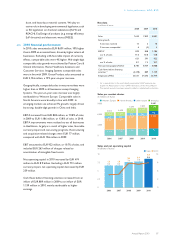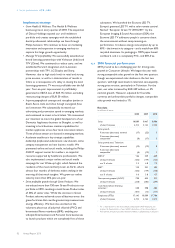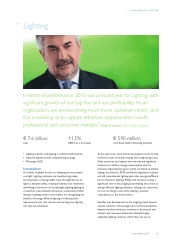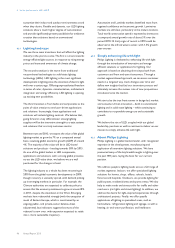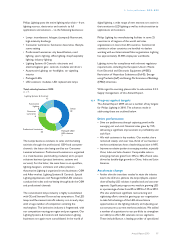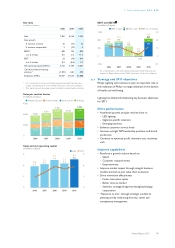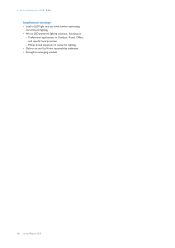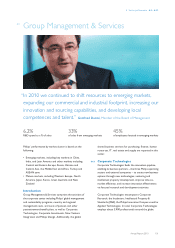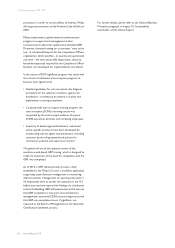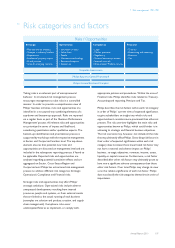Philips 2010 Annual Report Download - page 97
Download and view the complete annual report
Please find page 97 of the 2010 Philips annual report below. You can navigate through the pages in the report by either clicking on the pages listed below, or by using the keyword search tool below to find specific information within the annual report.
6 Sector performance 6.3.3 - 6.3.4
Annual Report 2010 97
Philips Lighting spans the entire lighting value chain – from
lighting sources, electronics and controls to full
applications and solutions – via the following businesses:
•Lamps: incandescent, halogen, (compact) fluorescent,
high-intensity discharge
• Consumer Luminaires: functional, decorative, lifestyle,
scene-setting
• Professional Luminaires: city beautification, road
lighting, sports lighting, office lighting, shop/hospitality
lighting, industry lighting
• Lighting Systems & Controls: electronic and
electromagnetic gear, controls, modules and drivers
• Automotive Lighting: car headlights, car signaling,
interior
• Packaged LEDs
• LED solutions: modules, LED replacement lamps
Total sales by business 2010
as a %
Lamps
40
Packaged LEDs/
LED solutions
7
Professional Luminaires
26
Consumer
Luminaires
6
Automotive
Lighting
8
Lighting Systems & Controls
13
The Lamps business conducts its sales and marketing
activities through the professional, OEM and consumer
channels, the latter also being used by our Consumer
Luminaires business. Professional Luminaires is organized
in a trade business (commodity products) and a project
solutions business (project luminaires, systems and
services). For the latter, the main focus is on specifiers,
lighting designers, architects and urban planners.
Automotive Lighting is organized in two businesses: OEM
and After-market. Lighting Systems & Controls, Special
Lighting Applications and Packaged LEDs/LED solutions
conduct their sales and marketing through both the OEM
and professional channels.
The conventional lamps industry is highly consolidated,
with GE and Siemens/Osram as key competitors. The LED
lamps and fluorescent retrofit industry is in its early days,
with a huge number of competitors entering the
marketplace. The luminaires industry is fragmented, with
our competition varying per region and per segment. Our
Lighting Systems & Controls and Automotive Lighting
businesses are again more consolidated. In the world of
digital lighting, a wide range of new entrants are active in
the transition to LED lighting as well as in the transition to
applications and solutions.
Philips Lighting has manufacturing facilities in some 25
countries in all regions of the world and sales
organizations in more than 60 countries. Commercial
activities in other countries are handled via dealers
working with our International Sales organization. Lighting
has approximately 53,000 employees worldwide.
Lighting strives for compliance with relevant regulatory
requirements, including the European Union’s Waste
from Electrical and Electronic Equipment (WEEE),
Restriction of Hazardous Substances (RoHS), Energy-
using Products (EuP) and Energy Performance of Buildings
(EPBD) directives.
With regard to sourcing, please refer to sub-section 5.3.3,
Supply management, of this Annual Report.
6.3.4 Progress against targets
The Annual Report 2009 set out a number of key targets
for Philips Lighting in 2010. The advances made in
addressing these are outlined below.
Drive performance
•Drive our performance through capturing growth while
managing cost and cash: Nominal sales grew by 15%,
delivering a significant improvement in profitability and
cash flow.
•Win with customers in key markets: Our market share
remained steady, and over two-thirds of our business/
market combinations have a leadership position in NPS.
•Improve our relative position in emerging markets, especially
China, India and Latin America: Comparable sales in
emerging markets grew from 34% to 38% of total sales,
driven by double-digit growth in China, India and Latin
America.
Accelerate change
•Further drive the transitions needed to retain the industry
lead in the LED era; optimize the lamps lifecycle, expand
share of leading LED solutions in professional and consumer
segments: Significant progress was made in growing LED
as a percentage of sales from 8% in 2009 to 13% in 2010.
We also undertook significant restructuring and
rightsizing efforts aimed at gearing up our organization
to take full advantage of the LED-driven future
opportunities in the lighting industry and adjusting our
cost structure to current market conditions. We added
a number of acquisitions to our portfolio to strengthen
our ability to offer LED solutions across segments.
These include Burton, a leading provider of specialized


